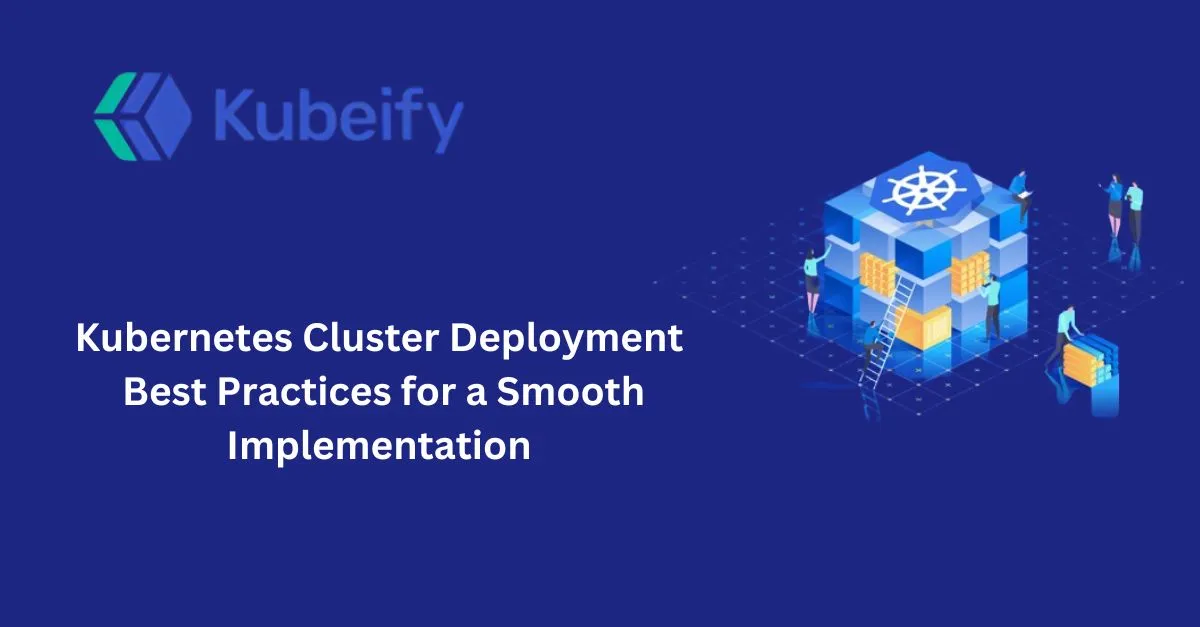AI Cloud
- Cloud Native Product Development
- Cloud Native FaaS
- Monolith to Microservices
- DevSecOps as a Service
- Kubernetes Zero Downtime

Kubernetes has become the de facto standard for container orchestration, enabling organizations to deploy, manage, and scale containerized applications seamlessly. However, deploying a Kubernetes cluster requires careful planning and adherence to best practices to ensure performance, security, and reliability. This blog will guide you through the best practices for Kubernetes cluster deployment to achieve a smooth and efficient implementation.
Before setting up a Kubernetes cluster, defining the architecture is crucial. Consider the following:
Cluster Size & Node Types: Determine the number of worker nodes based on workload demands.
High Availability (HA): Deploy multiple control plane nodes for redundancy.
Multi-Zone Deployment: Spread nodes across multiple availability zones to improve resilience.
There are several Kubernetes distributions available, such as:
Managed Kubernetes Services (e.g., Amazon EKS, Google GKE, Azure AKS) for reduced operational overhead.
Self-Managed Kubernetes (e.g., Kubeadm, Rancher, OpenShift) for more control and customization. Choose a distribution that aligns with your organization’s needs and expertise.
Security should be a top priority in any Kubernetes deployment. Key practices include:
Role-Based Access Control (RBAC): Enforce least privilege access.
Network Policies: Restrict communication between pods using Kubernetes network policies.
Secrets Management: Store sensitive information securely using Kubernetes Secrets.
Pod Security Standards: Define and enforce pod security policies to prevent privilege escalation.
A well-configured networking setup ensures smooth communication between pods and services. Best practices include:
Use CNI Plugins: Implement Container Network Interface (CNI) plugins like Calico, Cilium, or Flannel for networking.
Ingress Controllers: Deploy an ingress controller (e.g., Nginx, Traefik) to manage external traffic efficiently.
Service Mesh: Use service meshes like Istio or Linkerd for advanced traffic management and observability.
Monitoring and logging help detect issues and optimize performance. Consider:
Metrics Collection: Use Prometheus and Grafana for real-time insights.
Logging Solutions: Deploy solutions like Fluentd, Loki, or ELK Stack (Elasticsearch, Logstash, Kibana) to centralize logs.
Tracing: Implement distributed tracing with OpenTelemetry or Jaeger.
Ensure your cluster can scale dynamically to meet demand:
Horizontal Pod Autoscaler (HPA): Scale pods based on CPU/memory usage.
Cluster Autoscaler: Automatically adjusts the number of worker nodes as needed.
Vertical Pod Autoscaler (VPA): Optimize resource allocation per pod.
GitOps enhances deployment efficiency and reliability:
Declarative Configuration: Store all configurations in Git repositories.
Continuous Deployment: Use tools like ArgoCD or FluxCD to automate deployments.
Version Control: Maintain infrastructure as code (IaC) for reproducibility.
Prepare for failures with a solid backup strategy:
Etcd Backups: Regularly back up the etcd database that stores cluster state.
Persistent Volume Snapshots: Use cloud provider snapshots or tools like Velero.
Disaster Recovery Testing: Regularly test recovery processes to ensure readiness.
Regular updates enhance security and performance:
Follow Kubernetes Release Cycles: Stay updated with new versions and deprecations.
Test Updates in Staging: Before applying updates to production, test them in a staging environment.
Automate Patch Management: Use tools like Kured for automated security patching.
Deploying a Kubernetes cluster requires a well-thought-out approach to ensure stability, security, and efficiency. By following these best practices, organizations can achieve a smooth Kubernetes implementation, reducing downtime and operational challenges while maximizing the platform’s benefits.
Are you looking to optimize your Kubernetes deployment? Implement these best practices and streamline your operations for long-term success!

Kubeify's team decrease the time it takes to adopt open source technology while enabling consistent application environments across deployments... letting our developers focus on application code while improving speed and quality of our releases.
– Yaron Oren, Founder Maverick.ai (acquired by OutboundWorks)
Let us know what you are working on?
We would help you to build a
fault tolerant, secure and scalable system over kubernetes.
